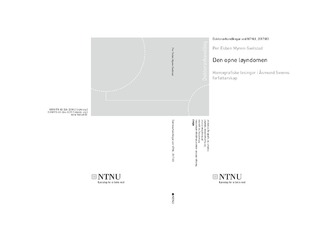| dc.contributor.advisor | Andersen, Britt | |
| dc.contributor.advisor | Heede, Dag | |
| dc.contributor.author | Myren-Svelstad, Per Esben | |
| dc.date.accessioned | 2017-05-05T08:14:19Z | |
| dc.date.available | 2017-05-05T08:14:19Z | |
| dc.date.issued | 2017 | |
| dc.identifier.isbn | 978-82-326-2239-9 | |
| dc.identifier.issn | 1503-8181 | |
| dc.identifier.uri | http://hdl.handle.net/11250/2441711 | |
| dc.description.abstract | Samandrag av doktoravhandlinga
Korleis kan likekjønna kjærleik, som i mange samanhengar er tabu, framstillast litterært? Avhandlinga Den opne løyndomen stiller dette spørsmålet til Åsmund Sveens (1910–1963) forfattarskap. Sveen var ein kritikarrost lyrikar, romanforfattar og avisskribent på 1930-talet. I 1940 meldte han seg inn i Nasjonal Samling, og arbeidde for Quisling-regjeringa. NS-engasjementet har bidrege til at Sveen er lite kjend i dag.
Sveen er ein av dei fyrste til å skildra homoerotikk i norsk litteratur. Denne studien utforskar korleis han går i dialog med sentrale idéar om seksualitet og kjønn i samtida. På 1920- og 1930-talet pågår det store diskusjonar om homoseksualitet innanfor psykoanalysen, sosialmedisinen og jusen. Eit hovudfunn i avhandlinga er at homoseksualitet blir kulturelt konstruert som noko som ikkje må omtalast direkte. I staden blir det alludert til gjennom tvitydige teikn som ofte kan tyda noko anna. Desse teikna blir i studien omtala som «homografiske markørar». Vidare er det eit sentralt poeng at slike markørar kjem mest til sin rett i Sveens hovudsjanger, lyrikken, sidan den er prega av nettopp det fleirtydige og gåtefulle.
Eit viktig og ubehageleg spørsmål er kvifor ein poet som skildra homoerotiske kjensler, tok del i den homofiendtlege nazismen. Studien understrekar dei uklåre grensene mellom det nazistiske manndomsidealet og ei potensielt homoerotisk idealisering av mannskroppen. Slike overlapp er kommenterte i forsking på samtidig skandinavisk biletkunst, men avhandlinga er det fyrste arbeidet som studerer Sveens homoerotiske motiv i ljos av dette. Slik går ho i rette med den populistiske påstanden at nazismen hadde spesielt stor appell blant homoseksuelle, samtidig som dei estetiske samanfalla mellom nazismen og den homografiske skrivemåten kan framhevast. Avhandlinga plasserer seg såleis i den såkalla antisosiale vendinga i homoforskinga, som interesserer seg for korleis homokulturen ikkje berre er politisk radikal, men òg ber på historier om skam, negativitet og det reaksjonære. | nb_NO |
| dc.description.abstract | Summary of the doctoral thesis
How might same-sex love, a taboo in many contexts, be depicted in literature? The thesis The Open Secret poses this question to the work of Åsmund Sveen (1910–1963). Sveen was a critically acclaimed poet, novelist and journalist in the 1930s. In 1940, he joined National Unity, the Norwegian collaborationist Nazi party, and worked for the Quisling government. His commitment to Nazism is part of the reason why Sveen is little known today.
Sveen is among the first to depict homosexuality in Norwegian literature. The present study explores how he goes into a dialogue with central contemporaneous ideas on sexuality and gender. In the 1920s and -30s, considerable discussions on homosexuality are ongoing within the disciplines of psychoanalysis, social medicine, and law. As one of its main findings, the thesis claims that homosexuality is culturally constructed as something which may not be mentioned in direct terms. Instead, it is alluded to through ambiguous signs that often may mean something else. These signs are termed “homographic markers.” Crucially, it is claimed that these markers are most prominent in Sveen’s main genre, poetry, a genre characterized by the ambiguous and enigmatic.
An important and uncomfortable question is why a poet depicting homoerotic feelings chose to participate in the homophobic ideology of Nazism. The study underlines the vague limits between the Nazi ideal of masculinity and a potentially homoerotic idealization of the male body. Such overlaps have been commented in research on contemporaneous Scandinavian visual arts, but this thesis is the first to apply this perspective to Sveen’s homoeroticism. Thus, the thesis confronts the populist notion that Nazism held a particularly strong appeal among homosexuals, while underscoring the common aesthetic traits of Nazism and the homographic strategy of writing. This thesis thus contributes to the so-called anti-social turn in queer studies, asking how gay culture is not only politically radical, but also carries stories of shame, negativity and the reactionary. | nb_NO |
| dc.language.iso | nno | nb_NO |
| dc.publisher | NTNU | nb_NO |
| dc.relation.ispartofseries | Doktoravhandlingar ved NTNU;2017:83 | |
| dc.title | Den opne løyndomen: Homografiske lesingar i Åsmund Sveens forfattarskap | nb_NO |
| dc.type | Doctoral thesis | nb_NO |
